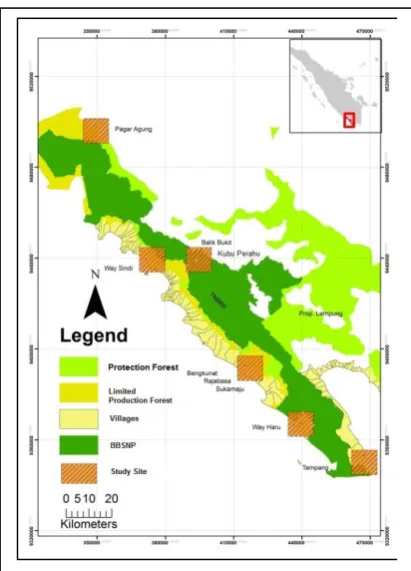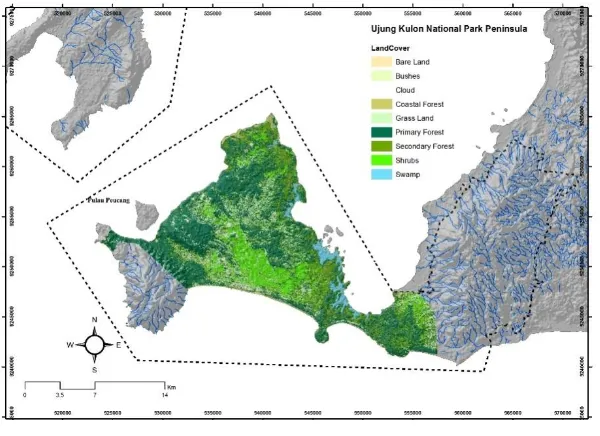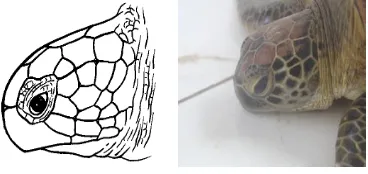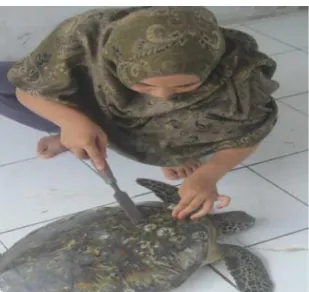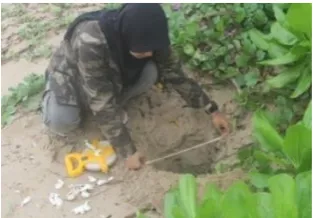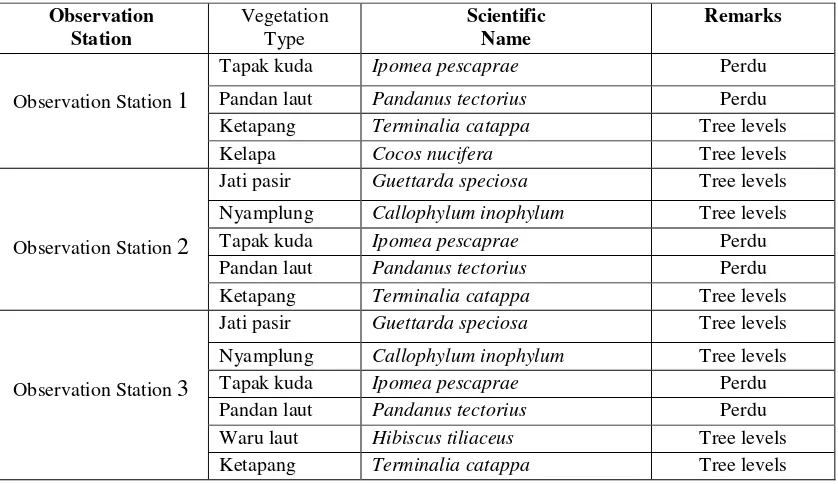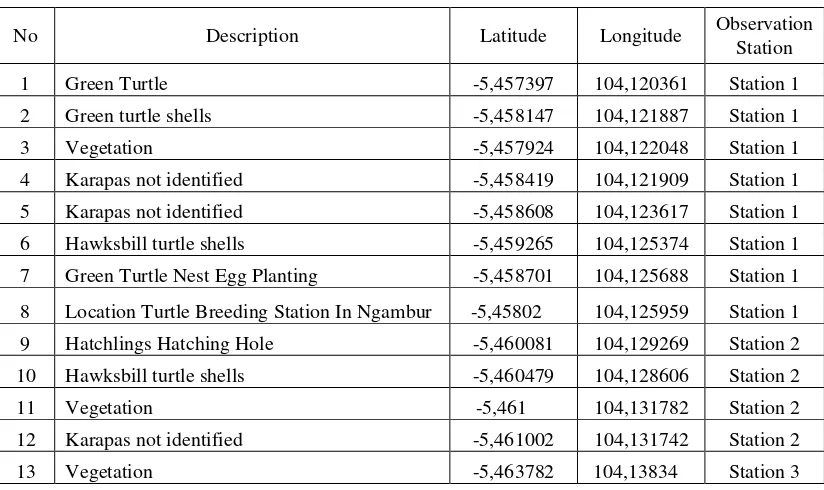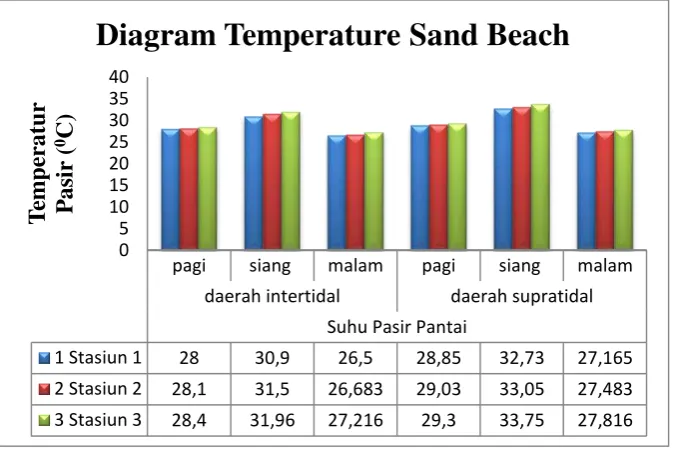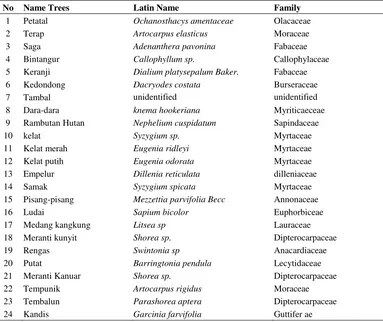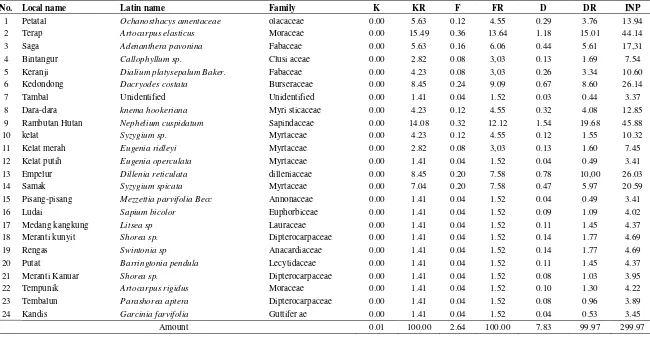“Conserving Sumatran Wildlife Heritage for Sustainable Livelihood”
PROCEEDING
ISBN: 978-602-0860-13-8
Organized by:
RESEARCH AND DEVELOPMENT CENTER OF ENVIRONMENT
INSTITUTE FOR RESEARCH AND COMMUNITY SERVICE
PROCEEDING IWS 2016
Person in charge:
Warsono, Ph.D.
Steering Committee:
Dr. Hartoyo, M.Si.
Organizing Commettee:
Dr. Erdi Suroso, M.T.A.
Editors:
Dr. Endang Nurcahyani, M.Si.
Dr. Ir. Sumaryo Gs, M.Si.
Published by:
Research and Development Center of Environment
Institute for Research and Community Service
University of Lampung
Jl. Sumantri Brojonegoro No. 1, Bandar Lampung 35145
Phone: +62-721-705173, Fax. +621-721-773798
E-mail: [email protected]
ISBN: 978-602-0860-13-8
All right reserved (including those of translation into other languages).
No part of this book may be reproduced in any form
–
by photoprinting,
WELCOMING SPEECH FROM CHAIR PERSON OF THE ORGANIZING
COMMITTEE
Distinguished guests,
-
Minister of Environment and Forestry Republic of Indonesia, Dr. Siti Nurbaya or
representing,
-
Rector University of Lampung, Prof. Dr. Ir. Hasriadi Mat Akin, M.P.
-
Honorable Keynote Speaker, Invited Speakers, participants, sponshorships, ladies
and gentlemen
Assalamu’alaikum
warohmatullohi wabarokatuh.
May God bless all of us.
Tabik pun.
It gives me great pleasure to extend to you all a very warm welcome to the 3
rdInternational
Wildlife Symposium (IWS 2016), here in Bandar Lampung.
Ladies and gentlemen, it is gratifying to note that symposium is designed to improve
awareness on wildlife conservation and sustainability in order to improve the welfare of
society. To increase the consciousness and understanding on the potenstial, economic value,
and sustainable management of tropical wildlife through bioengineering application and to
strengthen international scientific network of biological and related scientiests to share and
exchange progress in various fields of wildlife research.
No matter how much we can do by ourselves on the institutional and national level, it is
never enough. International level of collaboration work would be the best answer. Therefore
I wish that this event which is attended by distinguished speaker and attendants from
Malaysia, India, US, and Indonesia, would be a great opportunity for us to establish
scientific collaboration between scientist internationally.
Hereby, on the behalf of Organizing Committee I acknowledge Dr. Siti Nurbaya, Minister of
Environment and Forestry Republic of Indonesia or representing, and also to Mrs. Siti Nur
Hidayati, Ph.D. (Middle Tennessee State University), as a keynote speaker, and also to the
following invited speakers, Dr. Ashley Brooks (WWF Tigers Alive Initiativ), Dr. Barney
Long (Global Wildlife Conservation), and drh. Dedi Candra (Way Kambas National Park)
for willingness to share their valuable knowledge and scientific information.
To make this symposium happen, I would like to gratefully acknowledge to the valuable
contributions from personal and institutional sponshorships including University of
Lampung, Doctor Coffee, Aska Jaya, PT. Nestle Indone
sia, Levi’s Indonesia, and Rumah
Kolaborasi (Ru-Ko). In particular, thanks a lot to the World Wide Fund (WWF) for
supporting the financing of this symposium.
works. All of them have been working since the begining of the planning stage and they are
still here today for all of us.
Despite our best efforts, it is inevitable that there is a lack in organizing this symposium and
I proudly apologize to all invited speakers, oral and poster presenters, attendants, donators,
and committee members.
Finally, I would like to offer my best wishes for a highly enjoyable, succesful, productive
and fruitful symposium.
Thank you so much.
Dr. Erdi Suroso
COMMUNITY SERVICE, UNIVERSITY OF LAMPUNG
Distinguished guests
-
Minister of Environment and Forestry Republic of Indonesia, Dr. Siti Nurbaya or
representing,
-
Rector University of Lampung, Prof. Dr. Ir. Hasriadi Mat Akin, M.P.
-
Honorable Keynote Speaker, Invited Speakers, participants, sponshorships, ladies
and gentlemen
Assalamu’alaikum warohmatullohi wabarokatuh.
May God give us health and happiness.
Tabik pun.
It is my great pleasure to welcome all speakers and participants to the 3
rdInternational
Wildlife Symposium 2016 (IWS-2016) held in Meeting Room 2
ndfloor Rektorat University
of Lampung, Bandar Lampung, Indonesia. I recognize that this symposium is principally
designed to enhance and strengthen the contribution of researchers to the wildlife
conservation. The theme of this event is
“Conserving Sumatran Wildlife Heritage for
Sustainable Livelihood”.
Therefore, I wish that this event will be a great opportunity and
wonderfull venue to lay down a cooperative framework and to internationally establish
scientific collaboration among scientiests.
Hereby, I appreciatively acknowledge Dr. Siti Nurbaya, Minister of Environment and
Forestry Republic of Indonesia, and also to Mrs. Siti Nur Hidayati, Ph.D. (Middle
Tennessee State University), as a keynote speaker, and also to the following invited
speakers, Dr. Ashley Brooks (WWF Tigers Alive Initiativ), Dr. Barney Long (Global
Wildlife Conservation), and drh. Dedi Candra (Way Kambas National Park) for delivering
their valuable scientific information.
My appreciation also goes to the Steering Committee, Academic Reviewers, and the
Organizing Committee that spend almost their valuable time to review, manage and organize
this symposium effectively. I also would like to gretefully acknowledge to the valuable
contributions from personal and institutional sponshorship and funding to make this program
happen.
Finally, I wish you all best wishes to have meaningfull and useful symposium. Thank you.
Wassalamu’alaikum warohmatullohi wabarokatuh.
Warsono, Ph.D.
REPUBLIC OF INDONESIA
AT 3
rdINTERNATIONAL WILDLIFE SYMPOSIUM
Bandar Lampung, 18 October 2016
Distinguished Participants,
Ladies and Gentlemen
Assalamu’alaikum wr.wb
Good morning and May God bless us.
It is my great honor and pleasure to attend to this event and deliver my speak. Let me
express my appreciation to University of Lampung in collaboration with WWF Indonesia for
organizing this symposium. Hopefully from this symposium which brings together scientific
community and field experts, where we share knowledge, experience and concern, can
enhance and synergize our efforts to cope issues in various aspects.
Ladies and gentlemen,
Indonesia should be proud to be a country which has rich biodiversity, reported it reaches
47.910 species, that makes Indonesia is well known as mega biodiversity country. At the
same time, Indonesia is responsible to promote sustainable use of biodiversity to improve
society and country’s well
-being.
This responsibility will be challenging for Indonesia, considering our country as one of the
hot spot of biodiversity loss. The threat mainly coming from habitat loss caused by
encroachment, forest fragmentation and forest fires as well as coming from illegal logging,
and trade.
Plants and wildlife are one of supporting elements for human life, which their existence hold
important and irreplaceable roles. Having that said, I would like to take this opportunity to
encourage all of us to protect and conserve the sustainability of wildlife and plants as
heritage for the next generation and sustainable livelihood.
Ladies and gentlemen,
Strategy and policy of Indonesian Government to secure the biodiversity are directed into
three focuses namely protection, preservation and sustainable use of ecosystem, species and
genetic resources. National regulation has been enacted, to mention some, including UU 5/
1990, UU 41/ 1999, UU 32/ 2009, PP 7/ 1999, PP 8/ 1999 as well as strategic and action plan
of several endangered and umbrella species such as sumatran tiger, orangutan, rhino,
sumatran elephant, javan eagle, tapir, proboscis monkey (
bekantan
), maleo, banteng and
babyrousa.
the spotlight of international attention. Threats on the biodiversity, for example illegal killing
of endangered species have and will always be connected with the issues of deforestation
and habitat destruction and these will be the entry points for discrediting and
black-campaigning against Indonesia, that in turn can be impacted to Indonesia’s products in the
global market. Thus saving the biodiversity requires active participation from all
stakeholders including private sector.
Biodiversity including ecosystem and genetic resources can and should be utilized in a
sustainable manner for human welfare such as for source of food, clothes, medicine, water,
energy, and oxygen, for controlling climate and disease, ecosystem balance as well as for
leisure.
Sustainable use of biodiversity, for example as I mention before for source of food has been
a main discussion in many forums. With the growth of human population, it is a must to
conduct study and formulate strategy to maintain our natural resources that can be utilized
not only for our generation but also for our kids’ generation and further. With this regard,
Indonesia as mega-biodiversity country plays an important role as source of germplasm
which may contain useful substance for human health or important for bioprospecting to
increase country’s revenue.
To illustrate, global trade on medicinal herbs reach approximately US$ 60 billion/year.
While protection of coral to support genetic resources for research on medicine can provide
revenue US$ 55-1.110 per ha/year in South East Asia (source: CBD). Indonesia revenue on
export from traditional medicine (jamu) reach US$ 113 million, while for domestic reach
US$ 100 million (source: BPOM 2007).
Ladies and gentlemen,
Despite having all of potency and opportunity, there are also threats and challenges facing
our existing biodiversity:
Globally, these includes pressure from human population growth which require demand for
land, food, energy and clean water; climate change; and increasing demand of genetic
resources for food and energy.
Nationally, these includes illegal logging, forest fire, encroachment, illegal trade, declining
of wildlife population, loss of habitat, invasive alien species, as well as low resources
capacity and quantity (human and fund) and lack of integrated database.
Hence enormous efforts have been taken by Government Indonesia namely:
a.
public awareness and campaign by involving religious leader and other groups for
promoting religious and local wisdoms as well as local engagement.
b.
to restore and protect the population at local level in their habitat to prevent further
damage to the population.
c.
Strengthen coordination among government institutions and networking with CSO’s.
Currently Ministry of Environment and Forestry Indonesia with relevant law enforcement
institutions (Police, General Attorney, Financial Transaction Reports and Analysis Center,
is expected that it could strengthen deterrent effects.
Ladies and gentlemen,
As we are all aware, illegal activity related to environmental and forestry including wildlife
illegal trafficking is now even more sophisticated, organized and transnational crime, which
involves a large network of actors that make up its own chain. We cannot stop it alone.
Therefore collaborative among relevant actor/ stakeholder is badly needed to tackle these
issues in effectively.
We believe that global collaboration through bilateral, regional and multilateral cooperation
can increase the effectiveness in combating illegal activities such as wildlife trafficking.
Hence, Indonesia has involved in global collaboration such as:
a.
Bilateral cooperation with Vietnam and USA
b.
Regional cooperation in the framework of the ASEAN-WEN (Wildlife Enforcement
Network)
c.
London Conference, Kasane Conference, The Hague Conference on wildlife
d.
Multilteral Cooperation: Interpol, CITES, Global Wildlife Programme
e.
We also have cooperation with International and National NGO concern in combating
wildlife crime, such WWF, WCS, etc.
In this moment, I would also inform that we are in the progress renewing our conservation
act in order to increase effectiveness of conservation efforts including wildlife law
enforcement.
Distinguish ladies and gentlemen,
To develop strategy on biodiversity conservation and sustainable use require strong research
and scientific evidence which will be needed to convince government agency and related
stakeholder to be aware and act on the right approach. Thus, active participation of scientific
community in communicating their knowledge should be appreciated and facilitated such as
through this event.
To conclude, the efforts for the conservation of biodiversity required the involvement of us
all, not just the governmental institutions only, but also private sectors, NGOs, civil societies
and scientific community. I sincerely hope that this symposium can provide a media for us
all to share knowledge, experience and concern, and to synergize all efforts.
Wasalamualaikum Warahmatullohi Wabarohkatuh
Bandar Lampung, 18 October 2016
Minister of Environment and Forestry,
HWC Safe Systems approach and the HWC Rapid Assessment tool
Ashley Brooks, Ph.D. - WWF Tigers Alive
1. What is the Safe Systems approach?
Current approaches to HWC globally insufficient to tackle the dynamic, emotive and complex challenge of minimizing and managing HWC.
Current approaches suffer from three critical weaknesses: 1) they have an isolated focus on the symptoms of conflict; 2) they lack coherent long term direction;
3) there is no basis to measure progress and impact.
1) They have an isolated focus on the symptoms of conflict;
• Current approaches do not integrate the six conflict elements. • Result is that actions:
• Only address symptoms • Require constant fundraising; • Do not address drivers of conflict;
• Limited ability to impact on human progress and wildlife conservation in that area
2) they lack coherent long term direction;
• Does not coalesce around desired long term goals • Result is that actions are:
- having little impact on the drivers of conflict;
- are often demonstrating false success by displacing the conflict
3) there is no basis to measure progress and impact.
• The focus on symptoms of conflict and the ‘current state’ means that HWC actions only measure against the progress of that action itself. E.g. the number of straying tigers.
• There is no ability to measure progress toward a ‘desired state’ of coexistence nor to demonstrate wise investment.
• Result is:
- No need to capture a baseline and therefore nothing to measure progress and impact against; - A lack of foundation for a long term commitment;
- A lack of ability to report at completion on the impact of the interventions; and
- Ultimately a weak ability to argue for stronger regulatory and policy foundations in government to mainstream HWC.
What is the Safe Systems approach?
• Has a single long term goal: to make the area safer. • Has a baseline for safety
• Ensures that all six conflict elements are addressed • Can be applied to any conflict context or species • Accounts for the drivers of conflict – e.g. habitat loss.
a) Policy and legislation b) Prevention
c) Monitoring d) Mitigation e) Response
f) Understanding the conflict
A site must have high coverage of each element. Elements must be integrated and reinforce each other.
3.
The 6 Elements of HWC
–
clearing up definitions
POLICY: Protocols, principles, provisions and measures undertaken by authorities which are stipulated in legislation and governmental plans
International law
National law
Wildlife and forest crime
National strategy
Translocation and respons
International collaboration
PREVENTION: Stopping or preventing HWC before an event occurs
• Education
• Livestock and crop management • Zero poaching
• Deterrents
• Barriers (eg electric fencing) • Habitat management • Land use planning • Early warning systems
MITIGATION: Reducing the impacts of HWC after ian event occurs
o Insurance schemes o Compensation programs o Interim relief schemes o Alternative livelihoods
RESPONSE: Measures taken to alleviate a specific or ongoing HWC event
• Response teams
UNDERSTANDING THE CONFLICT: Research into all aspects of the conflict profile
Hotspot mapping
Spatial and temporal characteristics
Social characteristics
Severity and impact
- management interventions over time
Monitoring
The Safe base Line-What does it means?
Safe Outcome Strategic Intent Safe
Person
• Does not hunt wildlife; practices wildlife friendly grazing; participates in wildlife education events; has access to “Innovation Fund” to develop own preventative measures; reports any HWC events; complies with rule of law relating to wildlife; has more than one income stream; has a safe working environment; is supported with alternative livelihoods as required.
Safe Wildlife • Is protected under law; has designated space to roam and reproduce; does not have access to livestock; is separated from people via barriers and land use plans; is supported by Response Teams; makes a positive contribution to local livelihoods.
Safe Assets • …
Safe Habitat • …
4.
Conducting a HWC Rapid Assessment at a site
The purpose of the RA Tool is:
to determine a baseline for how safe each part of the system (people, their assets, wildlife and habitat) is.
to determine the scale and gaps of current HWC interventions. to determine the effectiveness and gaps of current HWC interventions.
1. Compile HWC information: Capture conflict trends and baselines (hotspots, impact, attitudes) 2. Rapid Assessment: Capture SAFE Baseline
3. Develop SAFE Strategy 4. Implement Strategy
5. Monitor [and repeat process]
Hotspot mapping
Number & location of wildlife killed in retaliation to conflict event
Number & location of wildlife crime cases recorded (involving snaring, trapping, poisoning, electrocution, hunting etc.)
Human population and settlement locations
Human population density
Impact and severity monitoring
o Number, location and cost of livestock killed or injured p/month; p/year o Number, location and cost of incidents of crop raiding p/month; p/year
o Number, location and cost of incidents of structures damaged / destroyed p/month; p/year o Statistics of crop loss
Through one-on-one surveys, desk analysis of existing data and reports, a multi-stakeholder workshop, or a combination of all.
The criteria should be backed by available data, information and verifiable evidence.
Given that many of the RA criteria rely on quantitative information, the RA can ultimately be automated.
5. Synthesizing results and strategy development
0% 20% 40% 60% 80% 100%
Safe Person
Safe Assets
Safe Wildlife Safe Habitat
Monitoring
• High chance conflict impacts livelihoods • Potential loss of tolerance
• High risk of retaliatory killing
• Habitat loss may drive conflict • External forces
may be stronger than internal defences
• Strong policies
• Strong and effective protection and law enforcement
• Wildlife numbers increasing / stable • High chance of regular conflict
• High reliance on patrolling • Potential loss of tolerance • High risk of retaliatory killing
COLLABORATIONS FOR ENDANGERED SPECIES RECOVERY
Barney Long
Director, Species Conservation Global Reserve Conservatio
Endangered Species Recovery
Red List Status is about risk of extinction “Success” is improvement in a species’ status As far as “Least Concern”
What is Fully Conserved
Successful species conservation is much more than avoiding extinction. It is conservation of a species with ecologically significant numbers, interacting fully with the full suite of other native species and processes. An integral part of a thriving ecosystem! “A species is fully conserved if it is viable, and ecologically functional, in each part of its indigenous range.”
Saltwater crocodile:
• “Least Concern” on IUCN Red List – stable or increasing population of up to 150,000 adults in northern Australia.
• But extinct across much of Southeast Asia, and ecologically extinct in most of the rest of the region. Hence, far from being “Fully Conserved”. “Least Concern”.
Planning for Recovery
The One Plan approach to species conservation is the development of management strategies and conservation actions by all responsible parties for all populations of a species, whether inside or outside their natural range. Field biologists, wildlife managers, and conservationists monitor wild populations and develop conservation strategies and actions to conserve threatened species. The zoo and aquarium community develops long-term goals for sustaining ex situ populations
Saola - One Plan Approach
The Saola Working Group works collaboratively to conserve Saola in nature, and to leverage Saola as a flagship for conservation of the bio-cultural diversity of the Annamite Mountains as a whole.
Saola - One Plan Approach
Park management Snare removal
Zero Poaching Research Monitoring
Readying for reintroduction
Saola - One Plan Approach
o Conservation breeding. o Rescue
Saola Working Group
IUCN Asian Wild Cattle Specialist group Vinh University
Smithsonian Conservation Biology Institute WWF-Greater Mekong
WCS
Institute of Ecology and Biological Resources Department of Forest Resources Management White Oak Conservation Center
GWC
Leibniz Institute for Zoo and Wildlife Research Zoological Society of London
Lao Wildlife Conservation Association IUCN
Cambridge University Wroclaw Zoo
Royal Zoological Society of Scotland
ZooParc de Beauval San Diego Safari Park Project Anoulak Center for Conservation of Tropical Ungulates
Africa Alive! Viet Nature
A coalition to address the extinction risk among the most threatened
non-marine vertebrates of Southeast Asia
Catalyse urgent actions to reduce immediate threats causing the decline of ASAP species by filling knowledge gaps, initiating new initiatives for species recovery.
Strengthen ongoing conservation action by facilitating partnerships, raising profiles and increasing financial support.
Convene and support dialogue among stakeholders by helping coordinate and streamline action.
Improve efficiency and impact of conservation action by promoting conservation best practice for species planning and impact monitoring.
Chester Zoo Mabuwaya Foundation Turtle Survival Alliance Conservation Species are not recovered by any single organization
WILDLIFE CONSERVATION PROGRAMS
Siti Nur Hidayati, Ph.D.
University of Tennesse, USA
Wildlife ?
Wildlife refers to living organisms (flora and fauna) in their natural habitats. But cultivated plants and domesticated animals are not included in wildlife.
Benefits of Wildlife
Wildlife is an essential component of various food chains, food webs, biogeochemical cycles and energy flow through various trophic levels. Preserves vitality and health of environment and provides stability to various ecosystems.
Threat to wildlife
Habitat loss
Population growth, industrialisation, and modernisation Pollution urbanisation
1. Air, water, soil, noise 2. Activities
- the use of synthetic materials, - waste of various toxicity 3. Indiscriminate hunting 4. Killing and poachi
Animal Preference on Vegetation
1. Landscape2. Habitat within the landscape 3. Plant species within habitats
Landscape Ecology
1. Matrix2. Patches 3. Corridor
(Barnes, T.G, 2000)
Habitat Fragmentation
Fragmentation begins with a small gap in the matrix. Over time the gaps may get larger. Shift in the matrix. (Barnes, T.G, 2000)
Habitat corridors
A strip of favorable habitat located between two large patches of habitat that facilitates dispersal (e.g., a narrow band of trees that connects forests).
Key Design Considerations
6. Restore historical connections and generally avoid linking areas not historically connected.
Habitat restoration
Why Native Plants
Native plants:
1. Fewer pest and disease problems than exotic (non native plants). 2. Adapted to local temperature and rainfall patterns.
3. Provide better nutritional requirements for native animals, and are the basis for delicately balanced food webs
What is the goal of the restorations?
Restoring a plant community or Restoring habitat? For which species? Species characteristics
- food requirements
- shelter/breeding requirements - mobility/dispersal ability
- response to environmental variability (temporal & spatial) - interactions with other species
Can the species colonies? Will population be viable?
Need to consider: 1. Quality of the habitat
2. Difficulty in reaching the habitat 3. Distance to the habitat
4. Difficulty in crossing the area between habitat
Conceptual Models of Spatial structure
drh. Dedi Candra
Way Kambas National Park, Lampung Indonesia
INTRODUCTION
The Sumatran rhinoceros or Two-horned hairy rhinos (Dicerorhinus sumatrensis) is now the most endangered and the most threatened rhino among the five surviving rhino species in the world. Estimates indicate that the numbers of wild Sumatran rhino was reducing very rapidly over the last 2 decades and now there remain less than 100 individuals in the whole world. Numbers are now so low that we may see the rhino finally vanish in the coming decade, if we do not act fast and massively now. In the 200 years since the Sumatran rhinoceros was first scientifically described (Fisher 1814), the range of the species has contracted from a broad region in Southeast Asia to three areas on the island of Sumatra and one in Kalimantan, Indonesia.
Characteristics of Sumatran Rhino:
Males are primarily solitary except for mating pairs activity and mothers with baby under 2 years old
Life span is shot, just 35-40 years, long gestation length of approximately 15-16 months, and age at sexual maturity estimated at 6-7 years for females and 10 years for males
Home range: Males up to 5,000 ha with often overlapping with female home range and females more small, just about 1,000 -1,500 ha.
Daily movements between feeding sites and wallows site are probably only a few kilometers per day. Longer treks are made when males and females go to saltlicks (5-10 km) and by males exploring their large ranges.
Water is never very far away in the habitats occupied by the Sumatran rhino.
THE SUMATRAN RHINO STORY
Sumatran Rhino in Captivity:
1985-1992 Sumatran rhino capture program. PHKA working together with HPLF (Howletts and Port Lympne Foundation) from England and SRT (Sumatran Rhino Trust) from America were captured 40 rhinos from areas being converted to plantations in Riau and Bengkulu province (18 rhinos), for the captive breeding program. In same period in Malaysia were success captured 22 rhino from Peninsular and Sabah. So the Sumatran rhino were distributed to few places such as Indonesia, England, US and Malaysia. Unfortunately 13 Sumatran rhino was died until 1993 because of various causes, in particular because of problems with food and digestion, poor husbandry and health care, and fatal fighting because of limited space and no reproduction did occur. So, we can say captive breeding program was failed, even thought the first rhino expert too confident about captive breeding success.
Howlett and Port Lympne England Zoo- failed
US (Bronx zoo, San Diego Zoo, LA zoo and Cincinnati zoo – Breeding 2001, 2004, 2007) – overall failed
Sungai Dusun and Zoo Malaysia - failed
Sepilok and Borneo Rhino Alliance Tabin Sabah Malaysia - failed Safari park Indonesia - failed
Ragunan and Surabaya Zoo Indonesia - failed
Sumatran Rhino Sanctuary Indonesia (breeding 2012) – still survive and running to date. On 2016 just Bina, one Sumatran rhino survive in the captivity with 39 Sumatran rhinos
was died.
SUMATRA RHINO EXTINCT IN MALAYSIA
and close to extinct Sabah, just 3 sumatran rhino (Dicerorhinus sumatrensis harrissoni )left in the rhino Sanctuary, they are Tam (2008), Puntung (2011) and Iman (2014) - Tabin Wildlife Reserve). 200 cameras running in Danum Valley on 2012, there is just one rhino lest and captured on 2014. The Sumatran rhino is now considered to be extinct in Malaysia (Hance, 2015), and the current conservation strategy there is to propagate the remaining rhinos in a captive breeding program (Payne, 2012). The Borneo Rhino Alliance (BORA) directs this program, and currently it seems there is no chance to re-introduce any rhinos back into the wild (Ahmad et al., 2013). Main conservation program is patrol, protection and intensive monitoring.
The Sumatran Rhino Population Problem in Indonesia right now is same with Malaysian condition 20 years ago:
Sumatran rhino population distributed in small population <15/habitat Male and female rhino is very difficult to meet because small and distributed. High Inbreeding potential
Just few rhino calves was born
The captive propagation plan largely failed through a fatal combination of diverse factors including dealing with a solitary species which is inherently difficult to breed, inadequate knowledge of rhino breeding biology and dietary requirements, cautious decision-making, poor hygiene in some facilities, weak collaboration, emphasis on capture of "doomed" rhinos rather than fertile rhinos, and a willingness to keep on doing the same thing and waiting in vain for a better result. Three calves were produced by one rhino pair in Cincinnati Zoo in 2001, 2004 and 2007 and 2 calves was produced by one pair in SRS in 2012 and 2016.
CURRENT POPULATION - ESTIMATES OF SUMATRAN RHINOS LEFT IN THE WILD
Strategy and Action Plan for the Conservation of Rhinos in Indonesia (2007-2012) in situ Conservation: overall failed
• Expand the wild population in Gunung Leuser, Bukit Barisan Selatan and Way Kambas National Parks by at least 30%
• Secure adequate habitat for viable wild populations in Kerinci Seblat National Park (500,000 ha), Bukit Barisan Selatan National Park (100,000 ha), Gunung Leuser National Park (700,000 ha) and in Kalimantan (500,000 ha).
• Translocation of animals from the southern parts of Bukit Barisan Selatan National Park (which has a relatively dense rhino population), to its relatively empty northern sections. The movement of rhinos will occur when security is assured in the northern areas
2012
WKNP 35 Sumatran rhinos in 2012 (Talukdar et al., 2012), indicating a strong recovery after being declared extinct in the Park in 1961 but rediscovered in the 1980s (Reilly et al., 1997) BBSNP during 2007-2008 estimated there were 21 ± 7.1 rhinoceroses in the Park (Pusparini and Wibisono, 2013). Based on patrol data, the distribution of rhinoceros signs had decreased by 70% during 2007-2012 (Talukdar et al., 2012)
Leuser Ecosystem 17 individuals were confirmed in a 250 km2 area in 2012 (Leuser International Foundation, 2012
2013-2014
declined more than 70% over the last two decades due to poaching for its horn as well as increasing destruction of its habitat.
Now, the populations are primarily threatened by small population size, habitat enroachment, the potential for catastrophic events, and invasive plant species, as well as poaching.
2015-2016
Kalimantan 4-15, Way Kambas 31-36, Leuser 26-36, BBS 16-35. Summary of Sumatra rhino PVA meeting in Bogor 2015:
Four location distribution Sumatran rhino in Way Kambas, BBS, Leuser, Kutai Barat, each site needed special solution and different challenge.
Build national level support for Sumatran rhinoceros conservation
Conservation effort is zero poaching, increasing individual, control of species invasive. Action points: build Intensive Protection Zone and Intensive Management Zone in each population and manage individual as metapopulasi
o Establish IPZs and ensure that all Sumatran rhinoceros are protected from poaching, deforestation, encroachment and habitat degradation
o Manage all Sumatran rhinoceroses from Indonesia and Malaysia as one meta- population and establish Intensive Management Zones (IMZs) at each site in Indonesia Conduct critical research and monitoring to measure effectiveness and inform and evaluate conservation management including - Monitor diseases within the surrounding livestock population.
Engage local communities, government authorities and the private sector in the conservation of Sumatran rhinoceros and their habitats.
Captive must be support to wild population.
Interesting fact about condition of Sumatran rhino to date:
1. Summary of TFCA rhino expert Meeting in Jakarta August 2016 (just ~72 Sumatran rhino left in in-situ habitat)
2. Camera/video trap in BBSNP during 3 years project just capture 6 photos of Sumatran rhino (~2/3 different individual rhino (unpublished WWF Indonesia). Population 17- 24 Rhinos (Footprint, Occupancy & CT), Footprint 30-40 rhinos (RPU) – confuse with Tapir footprint? Nobody know what the real number of sumatran rhino in the field.
3. Camera/video traps in WKNP and RPU activities ~ 25 rhinos (TERMA). Footprint 31-36 rhinos (RPU)
4. Leuser ~ 12 rhino from (2-15) 6 different area (KEL)
5. Sumatran Rhino Population in the area which have intensive protection and monitoring (RPU 1995-now) continuing to decreased or stagnant (TNBBS and TNWK) - no overall indication of recovery of the wild populations
6. Rhino zero poaching (TNBBS and TNWK) - no recorded poaching events – real or nor? Protection and habitat restoration are no longer sufficient to ensure the Sumatran rhino’s survival.
7. Camera trap and Fecal DNA – low result
8. No info about rhino death in BBS 2001, TNWK (1 or 2) on 2006
9. Just 3-10 Sumatran (Kalimantan) rhino survival, capture and translocation protocol to rescue the sumatran wild rhinos (Najaq) from remote hill forests in Kutai Barat. The capture of isolated Sumatran rhinos is indeed inherently risky, but leaving isolated animals in a place where they cannot find a breed and snare on the leg has far greater risks. Although Najaq’s death is tragic, we have learning much from this experiences to continue its rescue efforts
No info about reproductive status individual of rhino in Leuser, BBS and WK.
No info about Genetic Plasticity and Heterositas Genetic status of population in Leuser, BBS and WK. The small size of Sumatran rhino populations make them vulnerable to inbreeding. Sumatran rhino population drastic decline about 90% during period 1984-2015.
Distribution habitat of Sumatran rhino in 5 sites (1984) and now just in 3 sites left (Leuser, BBSNP and WKNP). The wild populations in Sumatera mostly have stagnated, declined or gone extinct.
Very small individual into population just 2-10 rhino, separated without access for transferred new blood (genetic exchange) between sub population
The essence of the problem now is only one breeding female’s success in captive (Ratu). A country in the south East Asia, Indonesia still is the best to save Sumatran rhino.
SUMATRAN RHINO CONSERVATION IN WKNP - CENTER OF EXCELLENT
Rhino Protection Unit
Protection Securing the rhinoceros and their habitat through operating Rhino Protection Units (RPU) and intelligence and law enforcement unit (ILEU). the activity of teh rpu are Intensive patrolling of areas to detect and destroy traps, interdict intruders and arrest suspected poachers, take actions against unauthorized utilization of natural resources in addition of rhino protection, conduct intensive and extensive surveys and monitoring of the rhino population, and Provide intelligence to assist in the apprehension of poachers. SRS has separate enclosures for each rhino, because in the wild Sumatran rhinos are solitary animals that live alone most of the time. The female and male Sumatran rhinos are kept separate until a willingness to mate is shown in their behavior in correlation with their sexual cycle. The mature secondary tropical rain forest of Way Kambas National Park provides natural habitat for the Sumatran rhino.
• 2008 Yayasan Badak Indonesia (YABI) with two manager (Animal and facility) • 12 June 2012 Andatu was Born
• 12 May 2016 Delilah was Born • 2014 back with one manager
make sure; when female have peak of estrous cycle if we need to run breeding program. Actually, not so difficult to breeding this endangered animal, two important activities are daily behavior monitoring and Ultrasound examination (Follicle development, Ovulation, Early pregnancy, Embryo development and Pathology condition). After we know the estrous cycle and then introduce them, if good response each other pair male and female in one place. During the female cycle just 4 days female receptive to the male and just about 12 hours good time to breeding success. The other important this is the rhinos must be health with good nutrition.
Miscarriage – Loss Pregnancy
There was no vaginal discharge, no change in her behavior, nothing that gave us a hint she had lost the embryo. She is very healthy. The embryos can be absorbed fairly quickly early on. We did track the uterine horns from cervix to both ovaries and not see any fluid in there. Ratu was lost pregnancy, that is sometimes happens and is not related to how the rhinos are being cared for or managed. Nobody is to feel responsible for the loss. It is simply the way nature works sometimes.
Breeding Success Story management board (GMPB) consisting of representatives of rhino range states, rhino breeding facilities and donors, has been meeting since 2005. One of GMPB successful is brought Andalas into captivity in Way Kambas and breeding program has succeeded with two captive births but all of them related. The only unrelated male is held separately in Sabah. The pace is too slow to save the species. Fresh ideas and perspectives are needed to help decide what to do next.
• Rare Sumatran Rhino Birth in Way Kambas National Park Lampung, Indonesia on June 23, 2012 early Saturday morning. The birth is the first in 124 years in a breeding center in Asia and is a significant advance in Indonesia’s conservation efforts for one of Earth’s most threatened species. One rhino calve is very important because he has one percent of the world’s sumatran rhino population.
Sumatran rhino prediction age in Indonesia and Malaysia captivity (estimation of Sumatran rhino productive age is under 30) – life span about 35-40 years old.
No SRS BORA Sex Age Productivity
potential for recessive lethal gen or abnormal, population stagnant or decline and bring species to exstint.
If the Sumatran rhino population just fewer than 100, what can we do? What needs to be done? What the best strategy for conserving the Sumatran rhinoceros? Good question but difficult to answer or the answer should be obvious. Without specific actions to bring Sumatran rhinoceroses together to boost production it is likely that the species will go extinct even if protection of suitable habitat increases. Need extreme or revolution action for Sumatran rhino conservation now!!! If Not, Sumatran rhino will be Gone...!!!!
Saving Sumatran rhinos in the wild? or Saving Sumatran rhino in the captivity?
GOOD EXPERIENCES TO SAVE ENDANGERED ANIMALS
The inspiration and lessons learned in bringing back species on the edge such Californian condor, black footed ferret, crested Ibis, red wolf, Indian rhino and white rhino, and to stop us from making the same mistakes that were made that led to the extinction of the Yangtze river dolphin, the Javan rhino in Vietnam, and the northern white rhino.
Solution needed
1. Review the situation and our existing strategies. Identify key issues on which action has to be taken.
2. Global strategy to manage the global population (both wild and captive) as a single metapopulation across national and international borders. The best example of success of a single metapopulation strategy is that of the greater one-horned rhinoceros Rhinoceros unicornis in Nepal and India (Talukdar, 2006; Martin et al., 2013).
3. The second agreed action is the continued deployment of Rhino Protection Units at sites with remaining breeding populations.
4. The third proposed action is the creation of intensive management zones, with increased protection and monitoring in areas where the Sumatran rhinoceros breeds naturally.
5. The fourth action of the conservation strategy is captive breeding. The development of advanced reproductive technology for captive breeding.
6. Strong governmental commitment and support to save Sumatran Rhino.
Action:
1. Review Strategy and Action Plan for the Conservation of Rhinos in Indonesia (2007- 2012) and change with Emergency plan for Sumatran rhino (need a comprehensive budget).
2. Rhino Protection Unit. Strict anti poaching operations, protection rhino population and habitat, intensive monitoring, apply ILEU each sites is important for Sumatran rhino conservation, BUT Sumatran rhino conservation program with small population must be use scientific assessment for: Make sure real viable rhino population viable. Find rhino and translocation of
isolated wild rhino with population < 5 into existing semi in-situ captive breeding. Act now to add animals to the population.
Securing priority areas (Leuser, BBS and WK).
Reproductive status including pathological status of reproductive organ
Index in-breeding and genetic variation(heterocyst) into population - create a real genetic reservoir to support the wild population
IPZ, IMZ, Sanctuary - Advance Reproductive Technology Diseases surveillance surrounding 3 different sites
Act now to truly manage captive Sumatran rhino population as one global population, with exchange of animals and gametes.
3. Sumatran Rhino Sanctuary in Lampung
b. SRS must be developed as a breeding centre for Sumatran rhino – framework SRS – change brands image SRS not only Sanctuary but real breeding centre. Semi in-situ BREEDING CENTRE – Natural breeding combine with reproductive technology. Framework SRS – change brands image SRS not Sanctuary anymore but real breeding centre: Human resource – upgrading staff, Equipment & Laboratory.
c. Reproductive technology: hormone modification for female, ultrasounds, EEJ (Artificial insemination has resulted in the births of five white rhinoceros calves in European zoos and three greater one-horned rhinoceros calves (Terri Roth, pers. comm.), AI, g. Few options to obtain male sperm quality is: h. Continue Natural Breeding
i. Sperm collection with Electro Ejaculator (EEJ) from Andalas and Andatu and Tam
j. Collaboration with Sabah (Tam’s Sperm for SRS‘s female rhino), IVF to Bina or Rosa k. Government policy and Mou need to be clarified
l. Genetic issue need to be finished – the need of a join analysis for assessment
m. Loan New Male from wild (doom rhino): Survey and identification dome rhino in Sumatera, Government policy, Capture – translocation, Adaptation at the SRS, Breeding program, Evaluation and KSDAE Policy: release rhino to the wild or just stay at the SRS (need release program issue).
4. Sumatran Rhino Sanctuary in Kutai Barat Kalimantan Timur
a. Find and capture all Sumatran rhino in Kalimantan and bring to sanctuary to captive breeding program
b. Government policy and Mou need to be clarified
REFERENCES
Abdul Kadir, H. 2009. Current status and threats of Sumatran rhinoceros (Dicerorhinus sumatrensis) in Peninsular Malaysia. In Report on the Meeting for Conservation of Sumatran and Javan Rhinos in South-East Asia (eds B.K. Talukdar, K. Crosbie, S. Ellis, W.S. Ramono, A.C. Williams & Sectionov), p. 8. Asian Rhino Specialist Group, Guwahati, India.
Ahmad AH, Payne J, Zainuddin ZZ. 2013. Debate Forum: Preventing the extinction of the Sumatran rhinoceros. Journal of Indonesian Natural History; 1(2): 11–22.
Agil, M., Riyanto, M.A.C.T., Sumampau, T., Hodges,K.&Van Strien, N.J. 2002. A program of managed breeding for the Sumatran rhinoceros at the Sumatran rhino sanctuary, Way Kambas National Park, Indonesia. In Proceedings of the International Elephant and Rhino Research Symposium (eds H.M. Schwammer, T.J. Foose, M. Fouraker & D. Olson), p. 303. Vienna, Austria. Andalas-Ratu Love Story Proves Conservation Efforts Can Work. Http://www.rhinos-irf.org/andalasloves-ratu [accessed 14 Agustus 2016].
Isnan, W.M., Subrata, D.D. & Van Strien, N.J. 2006. Annual Report: Indonesian Rhino Conservation Program, Bogor, Indonesia.
GMPB (Global Management and Propagation Boar) for Sumatran rhino, 2012. Konservasi Sumber Daya Alam Dan Ekosistem – KLHK, 2016
Miller, P.S., Lees, C., Ramono, W., Purwoto, A., Rubianto, A., Sectionov, Talukdar, B., and Ellis, S. (Eds.) 2015. Population Viability Analysis for the Sumatran Rhino in Indonesia. Apple Valley, MN: IUCN/SSC Conservation Breeding Specialist Group.
MoF (Ministry of Forestry). 2007. Stretgy and action plan for the conservation of rhinos in Indonesia. MoF, Republic of Indonesia.
Payne J, Ahmad AH. A comment on 'sex and the single Rhinoceros' by Henry Nichols. 2012. Available:http://www.borneorhinoalliance.org/featured/a-comment-on-sex-and-the-
single-rhinoceros-by-henrynicholls/.[accessed 2 August 2016].
Pusparini W, Sievert PR, Fuller TK, Randhir TO, Andayani N. 2015. Rhinos in the Parks: An Island-Wide Survey of the Last Wild Population of the Sumatran Rhinoceros. PLoS ONE 10(9): e0136643. doi:10.1371/ journal.pone.0136643
Pusparini W, Wibisono HT. 2013. A landscape-level assessment of Sumatran rhinoceros distribution in Bukit Barisan Selatan national park, Sumatra. Pachyderm; 53: 59–65.
Schaffer, N.E., Agil,M. And Bosi,E. 2001. Utero-ovarian pathological complex of the Sumatran rhinoceros (Dicerorhinus sumatrensis). In Abstracts of the International Elephant and Rhino Research Symposium (eds H.M. Schwammer, T.J. Foose, M. Fouraker & D. Olson), pp. 322. Vienna, Austria.
SRS (Sumatran rhino sanctuary) report, 2000-2015 SRCS (Sumatran rhino crisis summit), 2013
Talukdar, B.K., Crosbie, K., Ellis, S., Ramono, W.S., Williams, A.C. & Sectionov. 2009. Report on the Meeting for Conservation of Sumatran and Javan Rhino in South–East Asia. Asian Rhino Specialist Group, Guwahati, Assam, India.
Talukdar, B.K., Sectionov And Campbell,C. 2012. Report on the Meeting for Conservation of Sumatran and Javan Rhino in South East Asia. Asian Rhino Specialist Group, Guwahati, Assam, India.Reilly J, Spedding GH, Apriawan. Preliminary observations on the Sumatran rhino in Way Kambas National Park, Indonesia. Oryx,
1997; 31(2): 143–150.
TFCA rhino expert meeting, 2016
WKNP (Way Kambas National Park report), 2000-2015
YABI (Yayasan Badak Indonesia). 2009. Annual Report: Yayasan Badak Indonesia, Bogor, Indonesia.
Pages
SAFE SYSTEMS: HWC Safe Systems Approach and the HWC Rapid Assessment tool (Ashley Brooks, Ph.D.) ...
1. PREVENTION MODELS TOWARDS HUMAN - TIGER CONFLICT (HTC) IN BUKIT BARISAN SELATAN NATIONAL PARK (BBSNP), LAMPUNG (Firdaus Rahman Affandi, Tugiyono, G. Nugroho Susanto, Elly Lestari Rustiaty) ...
1 -- 10
2. IMPACT OF ANIMAL HOUSING TOWARDS WORMS INFECTION IN LOCAL BEEF CATTLE FARMS IN DUKUHBADAG VILLAGE,
CIBINGBING, KUNINGAN, WEST JAVA, INDONESIA: AN ANALYSIS (Retno Widyani, Fitri Dian Perwitasari, Mus Nilamcaya, Ida Herawati) ...
11 -- 17
3. ESTABLISHING BASELINE DATA ON FISHERMAN AND FISH CAUGHT ON THE SERKAP RIVER, KAMPAR PENINSULA, RIAU (Sidiq Purwanto) ....
18--24
4. WALKING THROUGH CONVERSION: A MONITORING OF ELEPHANT MOVEMENT IN DEGRADED FOREST OF TESSO NILO LANDSCAPE (Febri Anggriawan Widodo, Wishnu Sukmantoro, Heri Irawan, Eka Septayuda, Yansen Gultom, Samsuardi, Sunarto, Nurchalis Fadhli) ...
25--29
5. EVALUATING THE INTERVENTION METHODS TO REDUCE HUMAN-ELEPHANT CONFLICT AROUND WAY KAMBAS NATIONAL PARK (Sugiyo, Ardiantiono, Agus Santo, William Marthy, Fahrul Amama) ...
30--36
6. JAVAN RHINO (RHINOCEROS SONDAICUS), BANTENG (BOS JAVANICUS) & OTHER MAMMALS COEXISTENCE IN UJUNG KULON NATIONAL PARK: SPATIAL AND TEMPORAL OVERLAP (Mahmud R, Rahmaningsih MD, Sunarto, Daryan, Firdaus AY, Muhtarom A, Setiawan R) ...
37--49
7. FILLING THE KNOWLEDGE GAP ON THE ENDANGERED ASIAN TAPIRS IN SOUTHERN PART OF TROPICAL RAINFOREST HERITAGE OF
SUMATRA (Ardiantiono, Fahrudin Surahmat, Tri Sugiharti, Wulan Pusparini) ....
50--57
8. PEKON MUARA TEMBULIH, NGAMBUR, PESISIR BARAT: PRELIMINARY STUDY ON THE CHARACTERISTICS OF TURTLE
HABITAT (Brina Wanda Pratiwi, Sugeng P. Harianto, Elly Lestari Rustiati) ...
58--65
9. SUMATRAN ELEPHANT (ELEPHAS MAXIMUS SUMATRANUST) FOOD COMPOSITION AND ITS PREFERENCE IN TESSO NILO NATIONAL PARK (Defri Yoza and Yuliantony) ...
66--77
10. DIVERSITY AND ABUNDANCE OF AVIAN COMMUNITY AT COASTAL LAGOONS IN BUKIT BARISAN SELATAN NATIONAL PARK, INDONESIA: WHY WATERBIRD IS LACKING? (Ani Mardiastuti, Yeni A. Mulyani, Lina K. Dewi) ...
Heri Irawan) ...
12. STUDY ONHEALTH CARE MANAGEMENT SYSTEM OF CAPTIVE SUMATRAN ELEPHANT (Elephas maximus sumateranus) IN Prof. Dr. Ir. M. RUBINI ATMAWIDJAJA ELEPHANT HOSPITAL, WAY KAMBAS
NATIONAL PARK (Firda Nur Islami, Dedi Candra, Diah Esti A, Priyambodo) ...
91--93
13. A PRELIMINARY STUDY ON POPULATION ESTIMATION TECHNIQUE OF SIAMANG (Sympalangus syndactilus)in WAY CANGUK RESEARCH
STATION, BUKIT BARISAN SELATAN NATIONAL PARK (Nafila Izazaya Idrus, Ryan Setiono, Fahrudin Surahmat) ...
94—98
14. HELMINTHES PARASITIC (PARAMPHISTOMUM SP) INFECTION ON THE SUMATRAN ELEPHANTS IN ELEPHANT TRAINING CENTER WAY KAMBAS NATIONAL PARK LAMPUNG ( Dedi Candra, Diah Esti, Elisabeth Devi, Catur Marsudi) ...
99--101
15. TRAPPING FRUIT EATING BATS IN WAY CANGUK RESEARCH STATION, BUKIT BARISAN SELATAN NATIONAL PARK: MIST NET VS HARP TRAP (M. Khairul Ikhwan, Eka S. Ariyanti, Fahrudin Surahman, Janjiyanto) ...
102--105
16. RESCUE SUMATRAN ELEPHANT BABY WITHOUT TRUNK IN WAY KAMBAS NATIONAL PARK LAMPUNG (Elisabeth Devi K, Dedi Candra, Diah Esti Anggraini, Nazarudin, Mahfud Handoko) ...
106--108
17. THE TABANID FLY BIODIVERSITY AND ITS POTENCY AS
TRANSMISSION VECTOR OF TRYPANOSOMIASIS TO THE JAVAN RHINO POPULATION WITHIN THE UJUNG KULON NATIONAL PARK (Gita Alvernita, Kurnia O. Khairani, Dariyan, Dyah Lukitaningsih, Supriyono, Dedy S. Pahlawan, Zaenal Gesit Kalbuadi, Upik Kesumawati Hadi) ...
109--113
18. ELEPHANT ENDOTHELIOTROPIC HERPESVIRUS (EEHV) MANAGEMENT IN ELEPHANT CONSERVATION CENTER WAY KAMBAS NATIONAL PARK LAMPUNG (Diah Esti, Dedi Candra, Anhar Lubis, M. Wahyu, Elisabeth Devi ) ...
114--116
19. AN EXPERT SYSTEM TO DIAGNOSE CHICKEN DISEASES WITH
CERTAINTY FACTOR BASED ON ANDROID ( Aristoteles, Kusuma Adhianto, Puja Putri A) ...
117--126
20. COMPARISON EFFECTIVENESS OF ANTIOXIDANT ACTIVITY EXTRACT HERBAL MIXTURE OF SOURSOP LEAF(Annona muricata), BAY LEAF (Syzygium polyanthum) AND PEGAGAN LEAF(Centella asiatica) (Khairun Nisa Berawi, Liana Shidarti, Samsu U. Nurdin) ...
127--132
21. THE UTILIZATION OF ISOLATEBacillus thuringiensisTO GRAYAK
LARVAE PEST(Spodoptera lituraFab.) ON CABBAGE (Brassica oleraceaevar. capitata Linn.) (Wibowo Nugroho Jati, Felicia Zahida, Sara Puspareni Prayitno)
133--137
22. LEG AMPUTATION OF TIMOR DEER (Hastono, S.D) ... 138--140
23. IDENTIFICATION OF THE SUMATRAN RHINO FOOD PLANTS IN WAY KAMBAS NATIONAL PARK LAMPUNG (Dedi Candra, Sumadi Hasmaran, Lamijo, Supriyono) ...
141--146
24. SURVEILLANCE ANTHRAX (Bacillus anthracis)IN SURROUNDING WAY KAMBAS NATIONAL PARK LAMPUNG INDONESIA (Dedi Candra, Arie Khoiriyah, Diah Esti Anggraini, Joko Siswanto) ...
147--151
25. GENOMIC DNA ISOLATION OFGAJAH SUMATERA(Elephas maximus sumatrensis)IN ELEPHANT TRAINING CENTER, WAY KAMBAS
NATIONAL PARK, EAST LAMPUNG (Elly L. Rustiati, Priyambodo) ...
152--155
27. THE EFFECTS OF A HEXANE FRACTION OF RED BETEL LEAF (Piper cricatum) ON LEARNING AND MEMORY IN MICE (Pratika Viogenta, Lilik Koernia Wahidah, Yudha Erlangga) ...
159--163
28. THE LOCAL KNOWLEDGE OF COASTAL ETHNIC COMMUNITIES OF PLANTS THAT EFFICACIOUS AS MEDICINE IN 5 DISTRICTS OF SOUTH LAMPUNG REGENCY (Arum Asterini, Yulianty, Tundjung Tripeni Handayani) ..
164--169
29. PHYTOTELMATA SPECIES AND ITS DISTRIBUTION IN SOUTH
PRINGSEWU, LAMPUNG (Putri Minggar Oktaviani, Emantis Rosa, Yulianty) ...
170--174
30. THETOXICITY OF PURIFIED ISOLATE OF POLAR EXTRACT POWDER LEAFSGLIRICIDIA MACULATAHBR. TO CACAO MEALYBUG
(PLANOCOCCUS MINORMASKELL ) (Ratih Andriyani, Nismah Nukmal, Emantis Rosa) ...
175--181
31. SOCIAL BEHAVIOR OF SPOTTED DEER(Axis axis)IN GUNUNG MADU PLANTATIONS INC.SANCTUARY LAMPUNG TENGAH LAMPUNG PROVINCE INDONESIA (Rita Gusmalinda, Bainah Sari Dewi, Niskan Walid Masruri) ...
182--188
32. THE COMPARISON OF TOXICITY PURIFIED ISOLATE OF WATER AND METHANOL EXTRACTS OF PAWDER LEAF GLIRICIDIA MACULATAON MORTALITY SOURSOP MEALYBUGPSEUDOCOCCUS CRYPTUS (Fahrul Aksah, Nismah Nukmal, Emantis Rosa) ...
189--196
33. DEVELOPMENT OF BOTANICAL INSECTICIDE FROM FLAVONOID OF COMPOUND LEAF EXTRACTGLIRICIDIA MACULATATO CONTROL COFFEE MEALYBUG PLANACOCCUS CITRI (Apriliyani, Nismah Nukmal, Emantis Rosa) ...
PREVENTION MODELS TOWARDS HUMAN - TIGER
CONFLICT (HTC) IN BUKIT BARISAN SELATAN NATIONAL
PARK (BBSNP), LAMPUNG
Firdaus Rahman Affandi1,2, Tugiyono1, G. Nugroho Susanto1, Elly Lestari Rustiaty1
1 Department of Biology, Faculty of Mathematics and Natural Sciences, University of Lampung,
Jl. Soemantri Brojonegoro, No.1 Bandar Lampung, Lampung.
2 Wildlife Conservation Society - Indonesia Program, Jl. Tampomas Ujung No. 35, Bogor, Jawa
Barat.
ABSTRACT
The population of Sumatran tigers (Panthera tigis sumatrae Pocock, 1929) is having fairly high pressure because of the forest habitat reduction. Human-tiger conflict (HTC) and its management in Sumatra have become a challenge in the means of tiger conservation because they generate material loss and deaths, that eventually reduce community tolerance towards its conservation attempt. Attack and predation towards cattle by tigers have made local community in some suburb villages of Taman Nasional Bukit Barisan Selatan (TNBBS / Bukit Barisan Selatan National Park) to develop some non-lethal control conventional approaches in order to protect their cattle and to prevent higher conflict to occur. Seven research location villages around TNBBS give important information in HTC prevention used by community in Bukit Barisan Selatan landscape. Questionnaire survey and structured interview have been done on 154 respondents. Some general local prevention models are anti-tiger attack cage or Tiger Enclosure Proof (TPE), fireplace around the cage, lighting or lamp in the cage, high platform cage, and night patrol and guard. From the questionnaire done, TPE model is evaluated effective in preventing tigers to enter the cage by local community. From 48 respondents stating that they have built TPE, there are 4 TPE respondents (8.3 %, n=48) having disruption and predation after TPE is built. The analysis result of Generalized Linear Model (GLM) shows that TPE
model is the best modeling that reducing the number of conflicts with delta value of Akaike’s Information Criterion’(AIC = 28,638), which is the smallest criterion value. Modeling interpretation defines that more TPEs built by a village of conflict area will decrease the number of occurring conflict frequencies.
Keywords: sumatran tiger, human, conflict, TPE, GLM
1. INTRODUCTION
Sumatran tiger (Panthera tigis sumatraePocock, 1929) is one of species key remaining on Sumatra Island. The threat of losing it existence is due to anthropogenic factors. This subspecies tigers very depend on the existence of forest [19] and they are having quite high pressure because of the reduction of forest habitat in Sumatra as the result of land use conversion and the increasing human population, so there is a conflict because of human activities around and inside forest [17]. “Critically
Endangered” status is embedded on this species[12], considering of its population in Sumatra that is less than 250 individuals left from the newest assessment [21].
Bukit Barisan Selatan National Park (BBSNP) in the province of Lampung is one of landscapes for tiger conservation (TCL / Tiger Conservation Landscape) that is stated in Strategy dan Rencana Aksi Konservasi Harimau Sumatera (STRAKOHAS/ Strategy and Plan of Sumatran Tiger Conservation Action)(Soehartono et al., 2007), that cannot be separated from the challenge of HTC management. There are 85 incidents of HTC recorded in BBSNP between years of 1998 – 2011, but there were no attacks or deaths.
Initiation of treatment through HTC mitigation in Bukit Barisan Selatan National Park (BBSNP) has been done in the areas of Talang Sebelas and Talang Kalinda (a cluster in the area of Desa Rajabasa, District of Bengkunat, Lampung Barat Regency) since 2005 by conservation agency of Wildlife Conservation Society – Indonesia Program (WCS-IP). Human and tiger conflict occurs with high frequency intensity, firstly recorded on 16th of December 2005, with the missing of goats from their
cage [1]. The search based on data of WCS-IP camera trap shows that their predators are Sumatran tigers. Up to 2007, they are recorded that 14 goats and a dog were the victims of tiger predation in Talang Sebelas, Desa Rajabasa, Bengkunat, Pesisir Barat [18].
The attack and predation on cattle by tigers have make local community in some suburb areas of BBSNP developing some conventional approaches that are non-lethal control for protecting their cattle and preventing higher level of conflict to occur. Moreover, WCS-IP has also developed a design of cattle cage that is tiger proof enclosure / TPE with a prototype that has been tested since 2005 in one of HTC hotspots surrounding BBSNP which are Desa Sukamaju and Rajabasa, Pesisir Barat Regency. The cage with this special design uses barbed wire to prevent tigers from entering, climbing, and jumping over the cage. Cage plank installation is done by nailing from inside to avoid the damage of plank by tigers. Some cattle predation cases show that tigers are able to pull planks installed from outside of the cage.
Conservation intervention is needed to build understanding and tolerant attitude of community on the existence of tigers, so they are not always considered as a threat for human life in suburb area surrounding BBSNP. The understanding on the relationship of the risk living side by side with the forest and conditions that will prevent and reduce the conflict risks between two entities, as well as the tolerant attitude towards wildlife existence such as tigers that certainly need forest as their life support is expected can create low conflict risk and the presence of tigers that is still maintained. The aim of this study is to set an effective model of human-Sumatran tiger conflict prevention based on non-lethal control approach that has been done by community during this time in villages that are affected by conflict surrounding BBSNP.
1. MATERIALS AND METHODS
2.1 Study area
Bukit Barisan Selatan National Park (BBSNP) was first established as a wildlife sanctuary because thisarea is home for several protected wildlife species (see Biological Conditions). During the third World National Park Congress on October 14, 1982 in Bali, the area was formally gazetted as national park based on Decree of the Minister of Agriculture No.736/Mentan/X/1982 (BBSNP 1999).BBSNP is a chain of the southern Barisan ranges located in southern Bengkulu and extending to southern Lampung.BBSNP is part of West Lampung, West Coast, and Tanggamus Regencies, Lampung Province and Kaur Regency (Bengkulu Province). Geographically, the park lies between the coordinates 429’ - 557’ S and 10324’ - 10444’ E. BBSNP covers an area of approximately 356,800 ha.
Fig 1. BBSNP landscape with the location of study site.
2.2 Methods
There are two approaches conducted to investigate which prevention model that has been done by community in study site. The first is by using supporting data (secondary) on conflict record in suburb area of BBSNP since 2008 obtained from conservation agency of Wildlife Conservation Society - Indonesia Program (WCS-IP) and which village that has built Tiger Proof Enclosure (TPE) as part of the means of conflict prevention, while primary data are extracted directly by using survey questionnaire and direct interview with local community about local prevention model that they have applied and its effectiveness level in preventing or reducing cattle predation risk by tigers. Respondent sample referred is local community affected by HTC, both in the first conflict level (directly see, hear, find sign of tiger presence, and others) and the second conflict level(having attack or predation toward their cattle). Time of study is done in January – March 2016.
1.3. Data Analysis
Questionnaire form completed will be decoded and put in to software application Minitab 17.0 to be processed as descriptive statistic data. Pearson Correlation Test, as well as using Generalized Linear Model (GLM) on data variable grouping is done including key topic of prevention model on conflict frequency occurring during this time in the village or conflict location. Data and information obtained will be tabulated, summarized, and presented in the form of table and graph. The result obtained will be recommendation for cattle owner in the village having conflict with Sumatran tigers.
1.4. Generalized Linear Model (GLM).
Predictor Linear Model:
η = Response Variable α = Intercept Value β =Coefficient Value
χ = Predictor Variable (categorical, nominal, discrete, continuous)
1.5. AIC Method in GLM
AIC method is a method used in selecting the best correlation model found by Akaike [7]. This method is based on maximum likelihood estimation (MLE).
To count AIC value, the formulation used is as the following:
k= the number of parameter estimated in correlation model n= the number of observations
e= 2,718 u = Residual
According to AIC method, the best regression model is the model that has the smallest value of AIC [3].
2. RESULT AND DISCUSSION
3.1. Local Wisdom in Preventing Human – Tiger Conflict.
Seven villages of study site give important information in preventing human and tiger conflict used by community is Bukit Barisan landscape. Questionnaire survey and structured interview have been done on 154 respondents. Some general local prevention models are Tiger Proof Enclosure (TPE), fireplace around the cage (Perun), lighting or lamps in the cage, high platform cage, and night patrol or guard. There are 48 active TPEs and 28 high platform cages that have been built by community in seven study sites since 2006. Generally, the condition of the habitat surrounding the cage is still in the form of coffee plantation and shrub cover that have not been cropped for a long time, so it potentially becomes crawling and hiding place for tigers.
In management of human and tiger conflict, prevention is an important part in order to reduce conflict. [17] stated that the principle of specific area describing conflict prevention method in an area cannot always be used in other areas. [4] added that for a long time human has been responded to wildlife disturbance by building varied methods for a long period of time.
In India, [8] reported that a fence and a field guard dog can reduce plant loss as the result of wildlife release such as elephants from the forest, but did not show significant result for reducing loss on cattle predation. Meanwhile,[13] also explained that fences surrounding the village are quite good for preventing the entering of cattle predators such as leopards(Panthera pardus).
